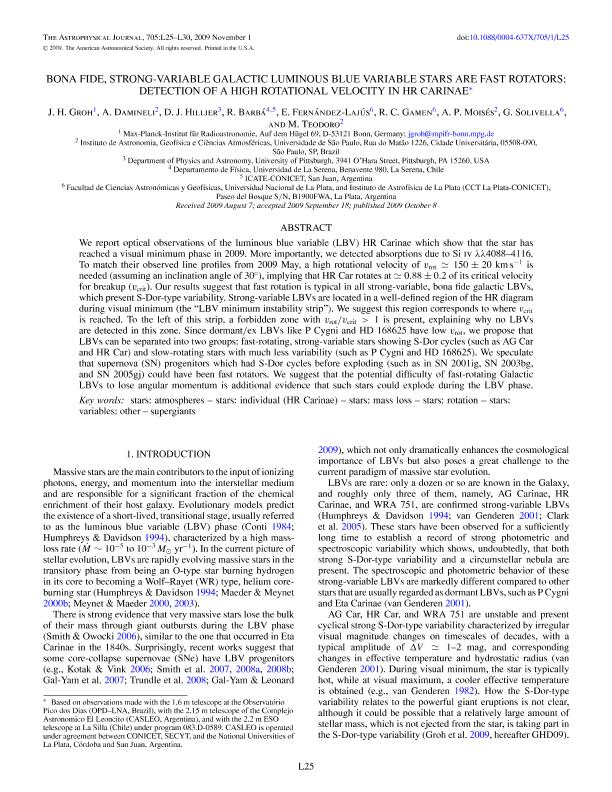Artículo
Bona-fide, strong-variable galactic Luminous Blue Variable stars are fast rotators: detection of a high rotational velocity in HR Carinae
Groh, J. H.; Damineli, A.; Hillier, D. J.; Barba, Rodolfo Hector ; Fernandez Lajus, Eduardo Eusebio
; Fernandez Lajus, Eduardo Eusebio ; Gamen, Roberto Claudio
; Gamen, Roberto Claudio ; Moisés, A. P.; Solivella, Gladys Rebeca; Teodoro, M.
; Moisés, A. P.; Solivella, Gladys Rebeca; Teodoro, M.
 ; Fernandez Lajus, Eduardo Eusebio
; Fernandez Lajus, Eduardo Eusebio ; Gamen, Roberto Claudio
; Gamen, Roberto Claudio ; Moisés, A. P.; Solivella, Gladys Rebeca; Teodoro, M.
; Moisés, A. P.; Solivella, Gladys Rebeca; Teodoro, M.
Fecha de publicación:
12/2009
Editorial:
IOP Publishing
Revista:
Astrophysical Journal
ISSN:
0004-637X
Idioma:
Inglés
Tipo de recurso:
Artículo publicado
Clasificación temática:
Resumen
We report optical observations of the Luminous Blue Variable (LBV) HR Carinae which show that the star has reached a visual minimum phase in 2009. More importantly, we detected absorptions due to Si IV 4088-4116 Angstroms. To match their observed line profiles from 2009 May, a high rotational velocity of vrot=150 +- 20 km/s is needed (assuming an inclination angle of 30 degrees), implying that HR Car rotates at ~0.88 +- 0.2 of its critical velocity for break-up (vcrit). Our results suggest that fast rotation is typical in all strong-variable, bona-fide galactic LBVs, which present S Dor-type variability. Strong-variable LBVs are located in a well-defined region of the HR diagram during visual minimum (the "LBV minimum instability strip"). We suggest this region corresponds to where vcrit is reached. To the left of this strip, a forbidden zone with vrot/vcrit>1 is present, explaining why no LBVs are detected in this zone. Since dormant/ex LBVs like P Cygni and HD 168625 have low vrot, we propose that LBVs can be separated in two groups: fast-rotating, strong-variable stars showing S-Dor cycles (such as AG Car and HR Car) and slow-rotating stars with much less variability (such as P Cygni and HD 168625). We speculate that SN progenitors which had S-Dor cycles before exploding (such as in SN 2001ig, SN 2003bg, and SN 2005gj) could have been fast rotators. We suggest that the potential difficulty of fast-rotating Galactic LBVs to lose angular momentum is an additional evidence that such stars could explode during the LBV phase.
Palabras clave:
Stars
,
Atmospheres
,
Hr Carinae
,
Mass Loss
,
Rotation
,
Variable Stars
,
Supergiant Stars
Archivos asociados
Licencia
Identificadores
Colecciones
Articulos(IALP)
Articulos de INST.DE ASTROFISICA LA PLATA
Articulos de INST.DE ASTROFISICA LA PLATA
Citación
Groh, J. H.; Damineli, A.; Hillier, D. J.; Barba, Rodolfo Hector; Fernandez Lajus, Eduardo Eusebio; et al.; Bona-fide, strong-variable galactic Luminous Blue Variable stars are fast rotators: detection of a high rotational velocity in HR Carinae; IOP Publishing; Astrophysical Journal; 705; 12-2009; 25-30
Compartir
Altmétricas



